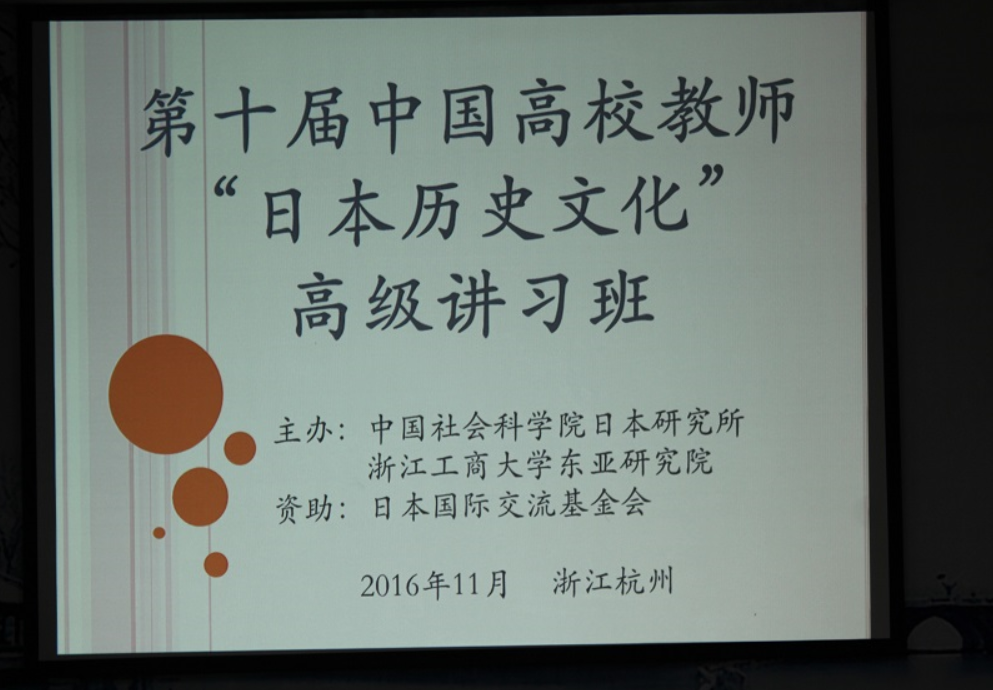|
Under the sponsorship of Japan Foundation and the joint organization of Japanese Studies Institute at Chinese Academy of Social Sciences and Institute of East Asian Studies at Zhejiang Gongshang University, the tenth Advanced Japanese History and Culture Course for University Teachers had been successfully conducted at Zhejiang Gongshang University from 18 to 25 November 2016. The keynote speakers included Research Director Zhang Jianli of Japanese Studies Institute at Chinese Academy of Social Sciences, Dean Chen Xiuwu of Japanese Research Institute at Northeast Normal University, Professor Yosiharo YAGI of Rikkyo University, Professor NO Sung Hwan of the University of Ulsan, Consul General Mr Kazuyuki KATAYAMA of Japanese Consulate General in Shanghai and Professor Wang Yong of Zhejiang University.
At the seminar on Japanese tea culture held by Research Director Zhang Jianli of Japanese Studies Institute at Chinese Academy of Social Sciences in the afternoon of 20 November 2016, the aesthetics and cultural history of Japanese tea ceremony were explored. As a skilled tea master, Zhang explained how Master Sennorikyu perfected Chanoyu (tea ceremony or hot water for water) or Sado ( the way of tea), the traditional Japanese connoisseurship and the ongoing transformation of Japanese tea houses. Through the side door nijiriguchi about 60 cm square, guests are forced to bow in order to enter the tea-room. The paramount grace and cultural implications of such elegant utensils as ceramic teas bowls, lacquered containers and folding screens were examined. Students thereby understood that chanoyu was a mental discipline in pursuit of wabi, which was a state of calm mind with a profound simplicity and much more than an elaborate ritual of tea preparation.
In the same afternoon, Dean Chen Xiuwu of Japanese Research Institute at Northeast Normal University presented his findings of the evolution of Japanese imperial fleet in the wake of the Meiji Restoration. In the perspectives of dimension, nationalistic thought and civilization in warrior culture, he explained how Japanese managed to construct an oceanic navy with a sense of national pride that was powerful enough to decisively defeat Qing Dynasty and emerged as the dominating new power in East Asia.
Mimizuka , also known as Hanazuka, means Ear Mound or Nose Mound but always translated as ear tomb or nose tomb in English. As a monument, Mimizuka can be found in many places in Japan such as Kyoto and Okayama. The Mimizuka in Kyoto was dedicated on 28 September 1597. Such tombs were dedicated to the sliced ears and noses of killed Korean army officers and civilians taken as a war trophy during Toyotomi Hideyoshi's invasions of Korea from 1592 to 1598. In Korea, this is collectively named Imjin War. Japanese warriors brought back hundreds of thousands of Korean ears and noses slain on the battlefields in Korean peninsular as proof of their cruelty. On 21 November 2016, in the presentation on Mimizuka in Japan, Professor NO Sung Hwan of the University of Ulsan in Korea proposed to level Mimizuka and build a new peace monument in view of war atrocities, brutality and imperialism implied by Mimizuka.
On 21 November 2016, Professor Emeritus Kazuaki KOMINE of Rikkyo University presented his seminar on Ryun I Na Ta Nyonin : Higashi Ajia Zenmyo , Professor Emeritus Komine is a famous research of medieval Japanese literature. With pictures, he compared the variations among three versions of Zenmyo in China, Japan and Korea. His wide-ranging research on medieval Japanese literature formed a source of inspiration to students.
On 24 November 2016, Consul General Mr Kazuyuki KATAYAMA of Japanese Consulate General in Shanghai presented his seminar on Introduction to Japanese Culture and Sino-Japanese Cultural Exchange. In fluent spoken Mandarin, Consul General Mr Katayama concisely explained multi-layered complex Japanese culture in a simple and interesting way and how Japanese evaluate different modes of behaviors as valuable and meaningful in terms of their own cultural values. He encouraged young Chinese and Japanese generations to increase cultural exchange consistently.
On the same day, Professor Wang Yong delivered his seminar on One Belt One Road and Sino-Japanese Relations. Notwithstanding a long time of hibernation, the Silk Road has all along been full of cultural uniqueness. In ancient Japan, Japanese deeply loved the art and civilization of the Silk Road which reached its peak in the Tang Dynasty. As a matter of cultural diplomacy, the Silk Road has played a unique role not only in foreign trade but also cultural exchange, stretching far beyond the boundaries of China itself. Professor Wang reminded students to shoulder this Silk Road spirit to develop civilizations on both sides of the continent under the project of One Belt One Road. He is optimistic about the scale of development under One Belt One Road to reach a scale considerably far greater than that of camels and horses in the good old days.
In addition to the aforesaid six seminars, Dean Wang Baoping of School of Oriental Language and Culture hosted International Conference on New Perspectives and Historical Data of Modern China and East Asia on 19 November 2016. On 23 November 2016, IEAS of Zhejinag Gongshang University hosted the fourth research conference on bitan . In these two events, all attendees of the tenth Advanced Japanese History and Culture Course for University Teachers actively expressed their views in academic interaction with keynote speakers and leading researchers, generating new approaches and ideas at the interface of academic and tertiary education communities.

|
